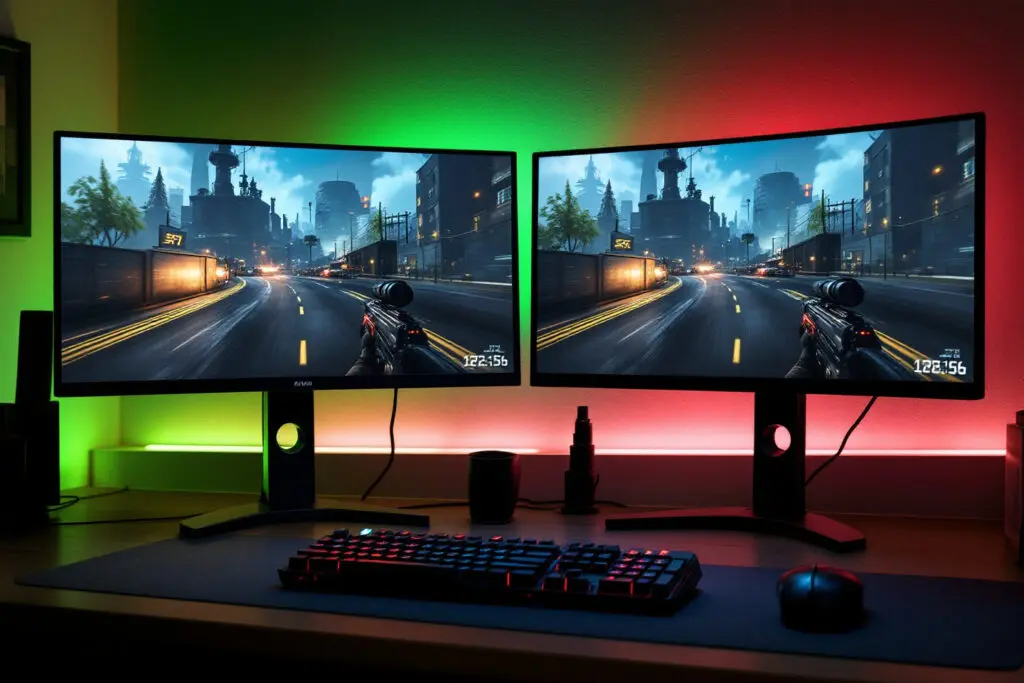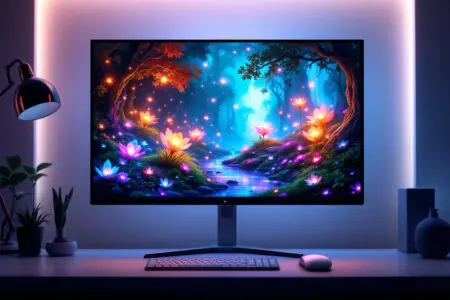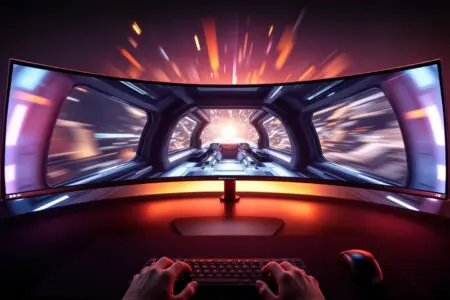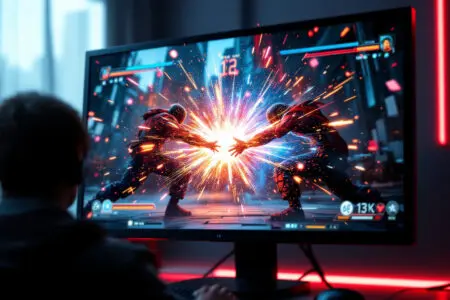You’ve done the hard part. Weeks, maybe even months, have been spent hunched over spreadsheets and benchmark charts. You’ve debated processors, scrutinized GPU coolers, and triple-checked your RAM timings. The beast is built. It hums with power on your desk. But you’re not done yet. You’ve hit the final boss: the monitor. This isn’t just a screen; it’s your portal. And suddenly, you’re drowning in jargon. Two names keep surfacing, locked in what feels like a holy war for your desktop. Welcome to the G-Sync vs. FreeSync debate. Choosing wrong feels like it could kneecap your entire multi-thousand-dollar rig.
It’s a decision that can leave even veteran builders frozen in their tracks. Do you throw in with Team Green and pay the Nvidia premium for G-Sync? Or do you join Team Red and embrace the open, wallet-friendly world of AMD’s FreeSync? For the longest time, the answer was pretty much made for you by your GPU and your budget.
But the battle lines have blurred, the tech has matured, and the choice is now more complicated—and way more interesting—than it’s ever been. This guide is your machete to hack through the jungle of marketing hype and technical specs. We’re going to break down what these technologies actually do, how they’re different, and help you figure out which one truly deserves that coveted spot in your setup.
More in Monitors Category
What is The Best Resolution for Gaming
Key Takeaways
- The Basics: G-Sync is Nvidia’s proprietary tech, a walled garden of smoothness. FreeSync is AMD’s open-standard answer. Both are designed to kill screen tearing and stutter for good.
- Hardware Matters: Real-deal G-Sync monitors have a special Nvidia chip inside. This adds cost but gives Nvidia total quality control. FreeSync doesn’t need a special module, which is why the monitors are cheaper.
- Price & Availability: Because it’s an open, royalty-free standard, FreeSync monitors are everywhere and generally cost a lot less than their G-Sync equivalents.
- The Peace Treaty: The “G-Sync Compatible” program changed everything. It’s Nvidia’s way of officially approving high-quality FreeSync monitors to work with their cards, giving you the best of both worlds.
- Your Bottom Line: The right choice comes down to your GPU, your wallet, and how much you care about guaranteed performance. If you’re on Team Red (AMD), it’s FreeSync, period. If you’re on Team Green (Nvidia), you can choose between pricey, guaranteed G-Sync or the massive, value-packed world of G-Sync Compatible displays.
First Things First, What Problem Are We Even Trying to Solve?
Before we pick a winner in the G-Sync vs. FreeSync fight, we need to meet the villain. It’s a glitch so ugly it can shatter your immersion in an instant. It’s called screen tearing.
So, What in the World is Screen Tearing?
Think of your GPU as a hyper-caffeinated artist, churning out masterpieces (frames) at a blistering pace. Your monitor is the museum, trying to hang each new painting. The museum’s speed limit is its “refresh rate,” measured in Hertz (Hz). A 60Hz monitor hangs 60 paintings a second. A 144Hz monitor hangs 144. Simple.
The chaos starts when the artist is working faster than the museum staff. Your GPU might be pumping out 90 frames every second, but your 60Hz monitor can only show 60. In its panic to keep up, the monitor might hang a new painting before the old one is even taken down. The result? You see the top half of one frame and the bottom half of another.
It’s a jagged, horizontal tear across your screen. It looks broken. It feels broken.
For ages, our only defense was V-Sync (Vertical Sync). It was a brute-force solution that told the GPU to slow down and wait for the monitor. Tearing was gone, but now you had a new enemy: input lag. That split-second delay between your mouse movement and the action on screen is a death sentence in any competitive game.
And How Does Adaptive Sync Fix This Mess?
This is where the real magic comes in. Instead of bossing the GPU around, adaptive sync flips the script and tells the monitor to be more flexible. It’s a game-changer.
Both G-Sync and FreeSync are types of Variable Refresh Rate (VRR) technology, or adaptive sync. They build a direct hotline between your graphics card and your monitor. With this link, the monitor ditches its rigid schedule. It no longer refreshes at a fixed 60, 120, or 144 times per second. Instead, it adjusts its refresh rate dynamically, in real-time, to perfectly sync up with the GPU’s output. When the GPU finishes a frame, the monitor shows it. Immediately. If the next frame takes a few milliseconds longer to render because of a massive in-game explosion, the monitor just waits patiently.
The result is motion so smooth it’s almost spooky. No tearing, no stuttering from mismatched frames, and none of the lag that V-Sync introduces. It is, and this isn’t an exaggeration, one of the most important upgrades to the PC gaming experience ever.
What is G-Sync? The Nvidia Power Play
Back around 2013, Nvidia looked at the mess of screen tearing and laggy V-Sync and decided to fix it themselves. They wanted a perfect, end-to-end solution they could control completely. The result was G-Sync, a proprietary technology that promised a flawlessly smooth, premium gaming experience. But that promise came with a hefty price tag, and the reason for that was all in the hardware.
How Did G-Sync Get Its Start?
What made the first G-Sync monitors so special—and so expensive—was a custom piece of hardware inside: a proprietary scalar module built by Nvidia. This wasn’t just a bit of firmware; it was a physical chip that completely replaced the monitor’s standard controller. This module became the brain of the monitor’s operation.
It was in charge of the variable refresh rate, color processing, and a host of other functions to make sure the picture was perfect. This hardware-centric model gave Nvidia iron-fisted control over the final product. They could guarantee an amazing experience because they manufactured the most important component inside the display. Of course, that custom chip, plus the strict licensing that came with it, meant you were going to pay more at the checkout.
Are There Different Kinds of G-Sync?
As time went on, the G-Sync brand expanded into different tiers. It’s critical to know the difference, because they offer very different things at very different price points.
- G-Sync Compatible: This is the tier that blew the whole G-Sync vs. FreeSync war wide open. In short, these are FreeSync monitors that Nvidia has personally put through the wringer and certified as offering a solid, tear-free G-Sync experience. They don’t have the Nvidia hardware chip, but they’re good enough to get the official nod from Team Green.
- G-Sync: This is the classic, hardware-based version. These monitors have the dedicated Nvidia processor inside. This guarantees a superb experience from top to bottom, with features like a full variable refresh rate range and expertly tuned variable overdrive to eliminate ghosting. To earn this badge, a monitor has to survive hundreds of brutal image quality tests.
- G-Sync Ultimate: This is the top shelf, the absolute best that money can buy. These displays not only have the advanced G-Sync processor but must also meet sky-high standards for things like breathtaking HDR, incredible contrast, and pro-level color accuracy. These are the monitors with the latest and greatest panel tech, like Mini-LED backlights, and they deliver an experience that is second to none—with a price tag to match.
And What is FreeSync? The AMD Underdog
While Nvidia was busy building its exclusive, high-performance G-Sync club, its arch-rival AMD came at the problem from the opposite direction. Instead of inventing a new, proprietary piece of hardware, AMD decided to build their solution on an open-source standard, bringing the same core benefit to the masses without the sticker shock.
How Does FreeSync Work Without Special Hardware?
FreeSync’s secret weapon is a feature that was already part of the DisplayPort standard, called Adaptive-Sync. Working with VESA (the group that manages display standards), AMD helped make this feature a core part of the DisplayPort 1.2a specification back in 2014. This move made adaptive synchronization an open, royalty-free standard. Any manufacturer could add it to their monitors without paying AMD a licensing fee. Because it works with the monitor’s existing hardware and doesn’t require a special, expensive chip, the cost of making a FreeSync monitor plummeted. This single decision is why the market is flooded with affordable FreeSync displays.
Are There Tiers for FreeSync Too?
You bet. AMD quickly realized that an open standard could lead to a huge range in quality. To help gamers know what they were getting, they introduced their own certification tiers, much like Nvidia.
- AMD FreeSync: This is the basic level. It certifies that the display will provide a tear-free and stutter-free gaming experience. However, there’s no strict requirement for a feature called Low Framerate Compensation (LFC), which is pretty important.
- AMD FreeSync Premium: This is the real sweet spot for most gamers. To get this badge, a monitor must have a refresh rate of at least 120Hz at 1080p resolution and, critically, it must support LFC. This ensures a smooth experience even when your frame rate takes a nosedive.
- AMD FreeSync Premium Pro: This is the top tier, building on the Premium level by adding stringent certification for High Dynamic Range (HDR) performance. It guarantees a fantastic experience in both standard and HDR games, with low latency and a wide color gamut, making for a seamless plug-and-play HDR setup.
My “Wow” Moment: Why Does This Tech Matter So Much?
I’ll never forget the first time I saw G-Sync with my own eyes. It was years ago, right after it hit the market. A friend of mine had just dropped what I thought was an insane amount of cash on an Asus ROG Swift, one of the first G-Sync monitors. He wouldn’t shut up about it, and to be honest, I thought he was just trying to justify the purchase. “How much better can it really be?” I thought.
So, I went over to his place, and he booted up Battlefield 4. The second he started sprinting across the map, my skepticism evaporated. My jaw hit the floor. The motion was so utterly, perfectly fluid that it broke my brain. It didn’t look like a game anymore; it was like looking through a window. I was so used to the subtle, ever-present screen tearing on my monitor, or the soupy, delayed feeling of V-Sync.
This was an entirely different reality. There was no tearing. No stutter. Just a pure, clean, one-to-one connection between the game and my eyes. It was a true “wow” moment. That was the day adaptive sync went from a “nice-to-have” luxury item to an absolute essential on my list. You don’t get it until you see it, and once you do, there’s no going back.
So, Let’s Talk Money. Why the Big Price Difference?
For the longest time, the biggest deciding factor in the G-Sync vs. FreeSync debate was your bank account. If you were running an Nvidia card and wanted that buttery-smooth gameplay, you had to be prepared to pay the “Nvidia tax.” This price premium was a direct result of their hardware-first strategy.
Is the G-Sync Hardware Module Really That Expensive?
In a word, yes. That dedicated scalar module Nvidia puts inside “G-Sync” and “G-Sync Ultimate” monitors is a real piece of hardware with a real cost. Beyond the chip itself, you have to factor in Nvidia’s R&D, the cost of integrating it into the monitor’s design, and the incredibly thorough testing and validation process every single model has to go through. All those costs get passed down the chain: from Nvidia to the monitor company, and ultimately, to you. It’s why you can find two monitors with practically identical specs on paper, but the G-Sync model will be a couple of hundred dollars more than the FreeSync one. You’re paying for that hardware and the guarantee of quality it represents.
Why Is FreeSync So Much Cheaper to Implement?
It all comes down to its open, free-for-all nature. Since FreeSync is built on the VESA Adaptive-Sync standard, manufacturers don’t pay AMD a single cent in licensing fees. They also don’t have to buy a proprietary chip from AMD. They can use standard, off-the-shelf components that already have the feature baked in, keeping their costs way down. This open approach has created a hyper-competitive market where dozens of companies are fighting for your dollar, which naturally pushes prices lower and lower. The end result is a staggering variety of affordable adaptive sync monitors for gamers at every budget level.
Does Performance Justify the Price in the G-Sync vs. FreeSync Battle?
For a while, the main defense of G-Sync’s high price was that it just plain worked better. That custom hardware provided a level of polish and consistency that many early FreeSync monitors couldn’t touch. But as the open standard has improved and monitor manufacturers have gotten better at implementing it, that performance gap has shrunk dramatically.
What About Variable Overdrive? Is That a G-Sync Exclusive?
This gets a little technical, but it’s important. “Pixel overdrive” is a trick monitors use to make their pixels change color faster, which cuts down on motion blur and ghosting. The problem is that a single overdrive setting doesn’t work well at all refresh rates. An aggressive setting that looks great at 144Hz might cause ugly artifacts called “inverse ghosting” when your framerate drops to 60Hz.
This is where the G-Sync hardware module shines. It provides variable overdrive, dynamically tuning the pixel response time on the fly to perfectly match the current refresh rate. This gives you the sharpest possible image with no artifacts, whether you’re at 165 FPS or 45 FPS. While early FreeSync monitors were notoriously bad at this, modern premium FreeSync displays have gotten incredibly good. The G-Sync module is still considered the gold standard for its flawless consistency, but the difference is no longer a deal-breaker.
What Happens When My FPS Drops Really Low?
This is where a feature called Low Framerate Compensation (LFC) saves the day. Any adaptive sync monitor has an operational range, like 48Hz to 144Hz. If your game’s performance dips below that 48 FPS minimum, VRR would normally switch off, throwing you back into a stuttery, tearing mess.
LFC is a brilliant fix. If your framerate drops to 35 FPS, LFC tells the monitor to display each frame multiple times, effectively doubling or tripling the refresh rate to 70Hz or 105Hz. This pushes the rate back inside the monitor’s VRR range, keeping your gameplay smooth even when your GPU is struggling. LFC is now a required feature for all G-Sync, G-Sync Compatible, and FreeSync Premium/Pro monitors, making it a standard feature on any modern gaming display you’d actually want to buy.
My Own Rig: The Budget Builder’s Dilemma
I had my own G-Sync vs. FreeSync showdown a few years ago. I was building a new PC around a GTX 1080 and was right at the edge of my budget. I had enough for a great 1440p 144Hz FreeSync monitor. To get a true G-Sync monitor with the same specs, I would have had to downgrade my CPU from an i7 to an i5.
This was before the “G-Sync Compatible” program was a thing, so pairing a FreeSync display with an Nvidia card was a total crapshoot. The choice was agonizing: a weaker PC with guaranteed smooth gameplay, or a more powerful rig with a monitor that might be a flickering, tearing nightmare? I got the i7 and the FreeSync monitor, and I crossed my fingers. I got lucky—it worked pretty well, though not perfectly. Today, thanks to the G-Sync Compatible program, that gamble is a thing of the past.
Can I Use a FreeSync Monitor with My Nvidia Card?
This is the big one. For years, the answer was “no,” but now it’s a massive “YES!” This shift has completely changed the G-Sync vs. FreeSync landscape, and it’s a huge victory for gamers.
The “G-Sync Compatible” Program: Nvidia’s Big Move
In early 2019, Nvidia waved the white flag. They released a driver that allowed their 10-series and newer cards to enable VRR on FreeSync monitors. At the same time, they launched their “G-Sync Compatible” program. Nvidia started testing hundreds of FreeSync monitors, and the ones that passed their demanding tests for image quality and a tear-free experience across a wide VRR range were given an official certification.
This means you can buy a monitor with the “G-Sync Compatible” badge, plug it into your Nvidia card, and enjoy a guaranteed great adaptive sync experience without the G-Sync tax. It’s truly the best of both worlds.
What if My Monitor Isn’t Officially “Compatible”?
You can still give it a shot. The Nvidia Control Panel includes an option to manually enable VRR on any display that supports the Adaptive-Sync standard. The catch is that it’s a lottery. Many uncertified monitors work perfectly. Some, however, can suffer from issues like brightness flickering or the screen blanking out. The good news is that there’s no harm in trying, and a quick Google search for your monitor’s model number will usually tell you what to expect.
What About Using G-Sync with an AMD Card?
This one, on the other hand, is an easy question to answer.
Nope. Can’t be done.
The G-Sync and G-Sync Ultimate ecosystems are locked down tight. That special hardware module inside is designed to talk to one thing and one thing only: an Nvidia GeForce graphics card. If you connect an AMD Radeon card to a true G-Sync monitor, it will work as a normal screen, but the adaptive sync functionality will be completely disabled.
What’s the Final Verdict? Which One Should I Actually Buy?
So, after all that, which monitor should you get in 2025? The answer is no longer about picking a side in a brand war. It’s about looking at your specific setup and needs.
If You Have an Nvidia GPU…
You’ve got the most choices, which is great but can also be overwhelming. Here’s the breakdown:
- For the Absolute Best, No-Compromise Experience: If you have a blank check and want the absolute best gaming experience possible, get a G-Sync Ultimate monitor. The combination of the advanced hardware and cutting-edge panel tech is unbeatable.
- For a Guaranteed Premium Experience: If you want a top-tier monitor with guaranteed flawless performance, a traditional G-Sync display is still a stellar choice. You’re paying a premium for that hardware and the peace of mind that comes with it.
- For the Smart Money and Best Value: For 95% of Nvidia users, an officially certified G-Sync Compatible monitor is the answer. You get a fantastic, validated adaptive sync experience, a massive selection, and you don’t pay the G-Sync tax.
- For Gamers on a Tight Budget: If you’re building a budget rig, a well-reviewed FreeSync monitor that isn’t on the official list can be a great way to save cash. Just do your homework first!
If You Have an AMD GPU…
Your life is much simpler. You’re buying a FreeSync monitor. The only question is which tier. I would strongly advise aiming for at least FreeSync Premium certification. This guarantees you get LFC and a 120Hz+ refresh rate. If you’re serious about HDR gaming, spending a bit more for FreeSync Premium Pro is a no-brainer.
Is One Technology Objectively “Better” Anymore?
Honestly, no. The war is over, and we, the consumers, won. The G-Sync Compatible program tore down the wall between the two ecosystems. A top-tier FreeSync Premium Pro monitor today can deliver an experience that’s just as good, if not better, than a G-Sync monitor from a few years ago. The debate has shifted from G-Sync vs. FreeSync to a much more important question: is this a good quality monitor overall? The adaptive sync tech is now just one line on the spec sheet.
In the end, all we want is a smooth, responsive, and beautiful window into our games. Thanks to this fierce competition, we have more ways to get that than ever. For more information on the open standard that makes much of this possible, VESA provides excellent documentation on the Adaptive-Sync standard for DisplayPort. So pick your GPU, set your budget, read reviews on specific models, and get ready to see your games the way they were meant to be seen.
FAQ – G-Sync vs. FreeSync
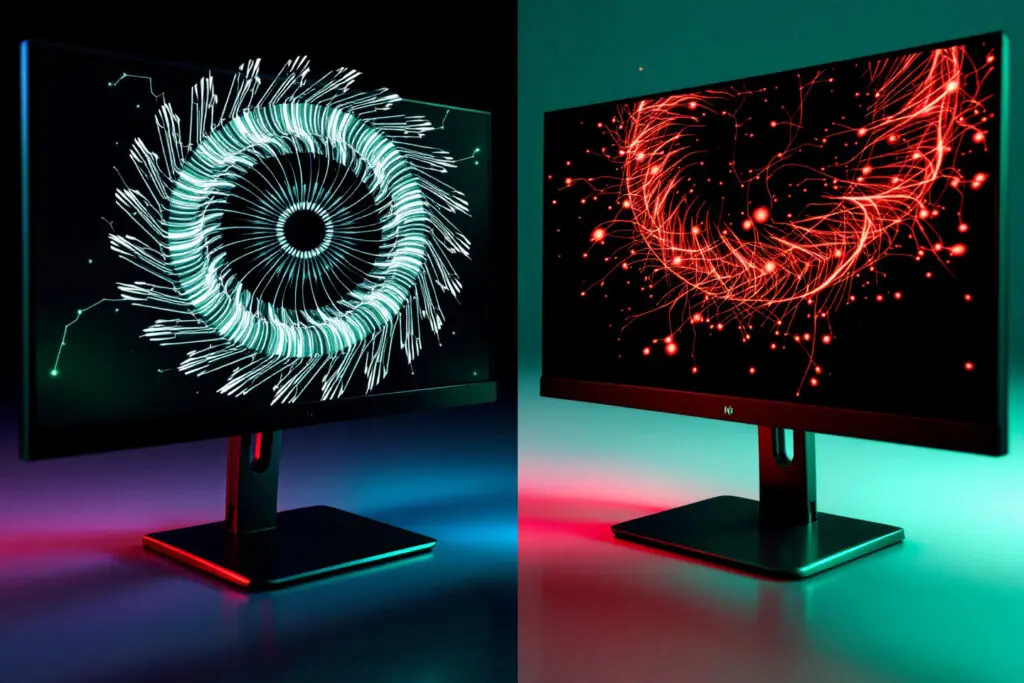
Why are G-Sync monitors generally more expensive than FreeSync monitors?
G-Sync monitors include a proprietary Nvidia hardware module, which increases manufacturing costs and price, whereas FreeSync monitors use standard components based on an open standard, making them more affordable.
Can I use a FreeSync monitor with an Nvidia GPU?
Yes, many FreeSync monitors are compatible with Nvidia GPUs if they are G-Sync Compatible, which Nvidia verifies through testing and certification, allowing for smooth adaptive sync performance.
What is the main difference between G-Sync and FreeSync?
G-Sync is Nvidia’s proprietary technology that uses a dedicated Nvidia hardware module for optimal performance, while FreeSync is an open standard developed by AMD that relies on existing hardware without requiring a proprietary chip.

